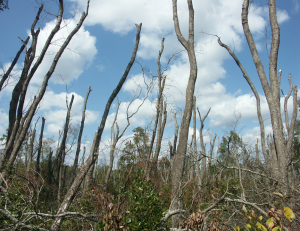
Hemlock woolly adelgids have affected half of all eastern hemlock ecosystems. Photo by Nicholas Tonelli.
Where can you go to find an eastern hemlock tree? Although threatened by the hemlock woolly adelgid, eastern hemlock has an extensive range.
Hemlock’s range encompasses great variability in the environment and genetic variability in the species. Hemlock often grows in cool, humid areas. In the southern Appalachians, the graceful conifer often grows at the edge of mountain streams. Its branches shade streams, helping them stay cool.
Over the millennia, hemlock’s range has fluctuated in response to cycles of global cooling and warming.
“Over time, different groups of eastern hemlock populations have diverged from each other,” says U.S. Forest Service collaborator and ecologist Kevin Potter. Potter is also a forestry faculty member at North Carolina State University. “They’re evolving on their own trajectories.” The result is several genetically separate lineages that appear to have evolved to adapt to different environmental conditions.
Anantha Prasad, a research ecologist at the Forest Service Northern Research Station, and Potter evaluated ecological differences between the areas inhabited by these lineages. Their results were published in the journal Biodiversity and Conservation.
“We combined genetic information with demographic and environmental models,” says Prasad. “One of our goals is to better understand whether the hemlock lineages are equally at risk or if they have different conservation requirements, especially under future climates.”
Prasad and Potter compared hemlock demographics and genetics across four genetic zones. The scientists also explored hemlock abundance under current and future climate conditions, as well as its colonization potential.
“Our results suggest habitat in the North-Central and Southwest zones could shrink, even under mild scenarios of future climate change,” says Prasad. “Seed collection should probably focus on these zones.”
For more information, and a sound recording of Kevin Potter describing this project, see this blog posting from the U.S. Forest Service Southern Research Station.
November 16, 2017




